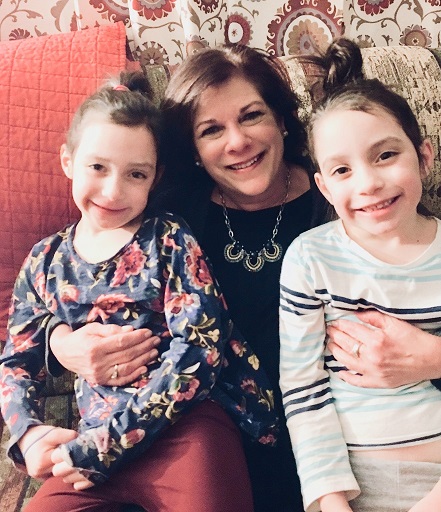


Nancy Lauritzen built up a high tolerance for the neck pain that plagued her for years, which proved useful when she had to battle insurance to approve surgery at Rockford Spine Center.
Lauritzen, now 61, suffered from osteoarthritis, also called degenerative joint disease, for nearly 20 years. She would experience flare-ups in her neck, then in her thumbs and toes, and then it became harder to walk.
Massage therapy helped with the pain for a short time, as did chiropractic care and a special neck pillow. Early on, she consulted with her primary care physician, who ordered a CT scan that showed deterioration of her cerebral vertebrae. Her doctor put her on Celebrex, an anti-inflammatory drug, which also decreased her pain for a bit.
Lauritzen tolerated the pain for a few more years until consulting with a pain doctor, who told her she had “the neck of an 80-year-old.” She had a series of neck injections, paired with physical therapy that included whole nerve and muscle stimulators and neck stretchers.
“I knew they would try to do noninvasive things as long as they could,” Lauritzen explained. “I always had the option to see a surgeon, but I decided to stick with nonsurgical procedures as long as I could tolerate them.”
But she wasn’t noticing that she would wince when turning her neck. She loves exercise but couldn’t look to the side to see her friend on a nearby treadmill. She avoided riding her bike outside and driving caused excruciating pain every time she had to turn her neck.
Lauritzen has been a nurse for more than 35 years and currently works at CGH Medical Center in Sterling, which is also where she lives. She’s an educator at the hospital and had to install a mirror at her workspace to decrease the amount of times she had to turn her neck. She reached a breaking point when the pain started regularly interrupting her sleep. “When I turned at night, it would wake me up. To move, it would hurt. Event to be still, it would hurt.”
She was referred to Dr. Michael Roh at Rockford Spine Center. Since 2014, Dr. Roh has seen patients and performed minimally invasive surgeries at CGH, while more complex spinal surgeries must still be performed in Rockford.
Dr. Roh told Lauritzen that her pain was coming from higher in her neck, which can’t be reached with pain injections.
“Eventually, the patient simply learns to turn the body rather than turning the head to avoid pain,” Dr. Roh said. “Once a patient is given an accurate diagnosis and corrective surgery is an option, patients are often more than happy to proceed with surgical care.”
She was scheduled for surgery in October 2016, but a week before the procedure, insurance denied the process. Understandably, Lauritzen was devastated.
“That’s when Dr. Roh and his team really put their gloves on for me,” Lauritzen said.
Dr. Roh said Lauritzen’s condition is uncommon, to the extent that painful C1-C2 arthritis is rarely discussed outside of advanced cervical spine surgical circles. As a result, many clinicians are unaware of this possible diagnosis for patients experiencing pain typically behind one ear and made worse by turning one’s head to the side of the pain.
“Unfortunately, the process of obtaining insurance approval for spine surgery has become increasingly onerous over the years,” Dr. Roh noted. “Even for common and routine conditions, patients must complete a full course of nonsurgical treatment before insurance will approve a surgical option.
“However, not all spinal conditions fall neatly within the predefined and somewhat arbitrary criteria that the insurance companies use. Therefore, spine surgeons are often required to advocate vigorously on behalf of their patients to help our patients obtain insurance approval.”
Lauritzen’s surgery was denied several times until Dr. Roh spoke to a company doctor who was willing to approve her surgery, even though the doctor was unaware of the condition. Dr. Roh provided scientific literature that documented C1-C2 posterior fusion was a proven and effective treatment for the painful C1-C2 osteoarthritis.
Lauritzen had the surgery in December 2016 and woke up with no pain. She wore a neck brace and had a drain for her neck, but she went home the following day.
“I went to my sister’s house for a week, and she totally pampered me,” Lauritzen recalled. “She had my bed all set up, my meals ready. I slept for three days straight. She was a godsend.”
She was off work for about six weeks and wore the neck brace the whole time.
“Dr. Roh did tell me I would have some limitations moving my neck from right to left, and I do. I can’t turn my neck completely, and I’m OK with that. The pain is gone, and that’s awesome,” she said.
There are many everyday activities – including playing with her 6-year-old twin granddaughters – that she can do better since the surgery.
“I can sleep, bend over to do yard work. I love doing stuff in the yard,” she said. “I can talk to my friend on the treadmill. I can turn my head to see when I’m backing out the car. It’s limited, but I can turn my body and not be in excruciating pain.”
Lauritzen encouraged others who may be experiencing similar pain not to give up. “There’s no reason that you need to live in pain like that. If you tried all avenues and surgery is the last resort, go for it.”